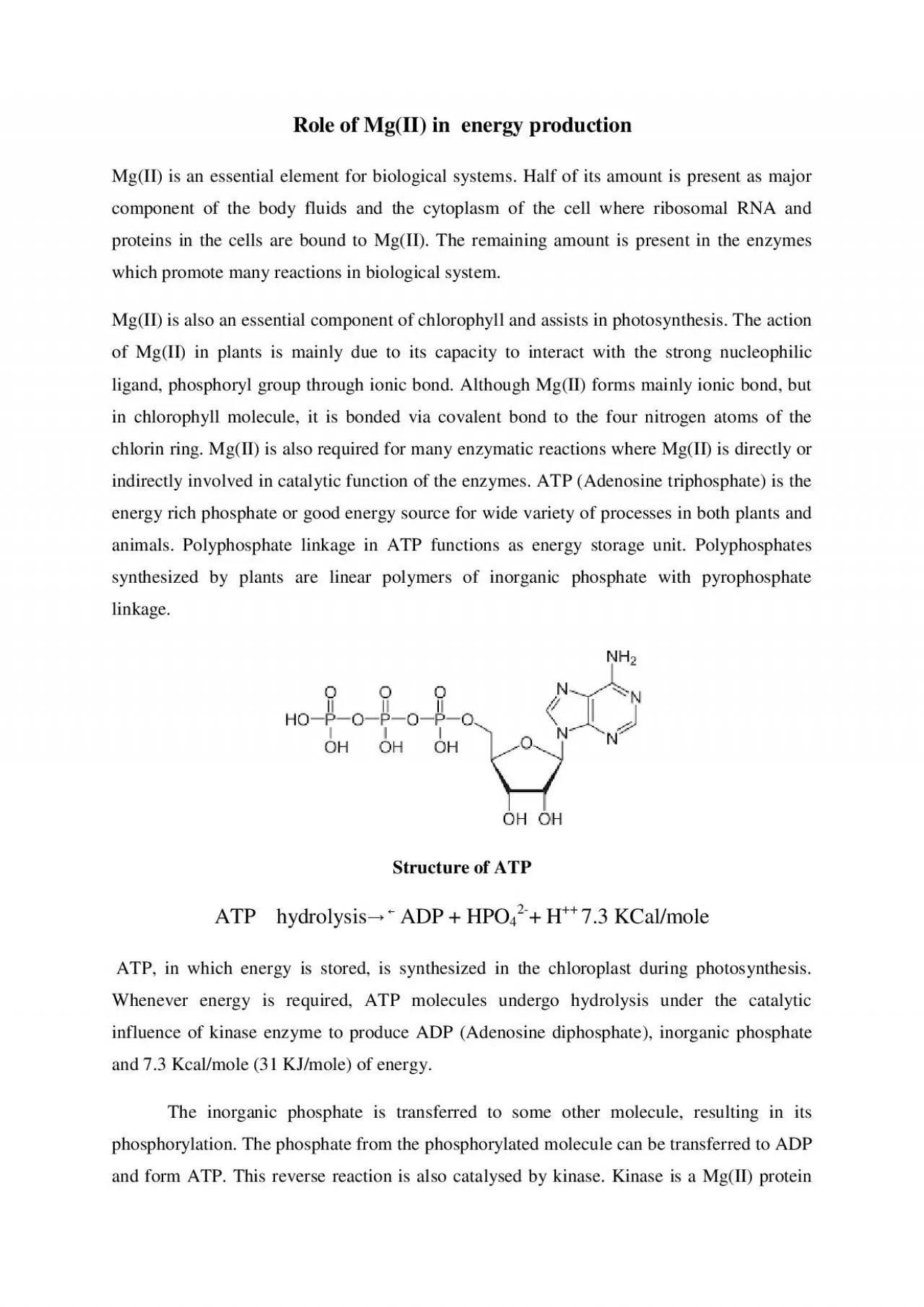

energy production MgII is an essential element for biological systems Half of its amount is present as major component of the body fluids and the cytoplasm of the cell where ribosomal RNA and pro ID: 945023
Download Pdf The PPT/PDF document "Role of MgII in" is the property of its rightful owner. Permission is granted to download and print the materials on this web site for personal, non-commercial use only, and to display it on your personal computer provided you do not modify the materials and that you retain all copyright notices contained in the materials. By downloading content from our website, you accept the terms of this agreement.
Role of Mg(II) in energy production Mg(II) is an essential element for biological systems. Half of its amount is present as major component of the body fluids and the cytoplasm of the cell where ribosomal RNA and proteins in the cells are bound to Mg( II). The remaining amount is present in the enzymes which promote many reactions in biological system. Mg(II) is also an essential component of chlorophyll and assists in photosynthesis. The action of Mg(II) in plants is mainly due to its capacity to inter act with the strong nucleophilic ligand, phosphoryl group through ionic bond. Although Mg(II) forms mainly ionic bond, but in chlorophyll molecule, it is bonded via covalent bond to the four nitrogen atoms of the chlorin ring. Mg(II) is also required for m any enzymatic reactions where Mg(II) is directly or indirectly involved in catalytic function of the enzymes. ATP (Adenosine triphosphate) is the energy rich phosphate or good energy source for wide variety of processes in both plants and animals. Polyphos phate linkage in ATP functions as energy storage unit. Polyphosphates synthesized by plants are linear polymers of inorganic phosphate with pyrophosphate linkage. Structure of ATP ATP hydrolysis → ADP + HPO 4 2 - + H ++ 7.3 KCal/mole ATP, in which energy is stored, is synthesized in the chloroplast during photosynthesis. Whenever energy is required, ATP molecules undergo hydrolysis under the catalytic infl
uence of kinase enzyme to produce ADP (Adenosine diphosphate), inorganic phospha te and 7.3 Kcal/mole (31 KJ/mole) of energy. The inorganic phosphate is transferred to some other molecule, resulting in its phosphorylation. The phosphate from the phosphorylated molecule can be transferred to ADP and form ATP. This reverse reaction is al so catalysed by kinase. Kinase is a Mg(II) protein which assists transfer of phosphate from ATP to substrate. Studies show that the distance between Mg(II) and ATP is too large for any interaction. Mg(II) may only be orienting the enzyme protein suitably t o interact with ATP, from its breakdown to ADP and phosphate and transfer of phosphate to substrate. This indicates that protein has the enzymatic role and Mg(II) acts as a coenzyme. Role of Mg(II) in chlorophyll Reference Books: Biological Inorganic Chemi stry by Robert Crichton Chemistry of the Elements by N. N. Greenwood & A. Earnshaw. Chlorophyll The chlorophyll molecule is an example of metalloporphyrin complex. The chlorophyll molecule is essentially consists of two parts: chlorin (a substituted po rphyrin ring) and phytol (the long carbon chain). The porphyrin ring is an excellent chelating ligand having macrocyclic tetrapyrole systems with conjugated double bond and various groups attached to the perimeter. The porphyrin ring can accept two hydroge n ions to form the +2 diacid or donate two protons and beco
me - 2anion. In chlorophyll, porphyrin ring is in anionic form with dipositive metal, Mg(II). Four nitrogen atoms of tetrapyrole ring are strongly bonded to Mg(II) in the centre of square planar arr angement. In chlorophyll, one double bond in one of the pyrrole ring is reduced and a fused cyclopentanone ring is also present. There is a long non polar phytol chain attached to carbon of one of the pyrole ring. This helps chlorophyll to bind with cell membrane. Structure of chlorophylls (use only to explain to students, not required for students) Chlorophyll a and b are two major types of chlorophyll found in plants and green algae. Both are involved in the process photosynthesis. They are different structurally in their side groups. The chlorophyll is essential in photosynthesis and allows plants to absorb energy from sunlight. Mg(I I) apparently serves several purposes: 1. It keeps the macrocycle fairly rigid so that the solar energy is not readily dissipated by thermal vibrations. 2. It coordinates with the water molecules that mediate in the hydrogen bonding between adjacent chlorophyll molecules in the stack. 3. It thereby enhances the rate at which the short - lived singlet excited state is involved in the redox - chain. 4. Promotes the formation of a relatively stable triplet state. However, it is by no means clear why of all metals, Mg(II) is uniquely suited for this purpose